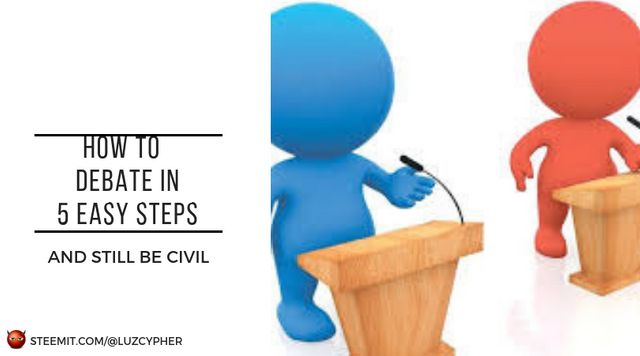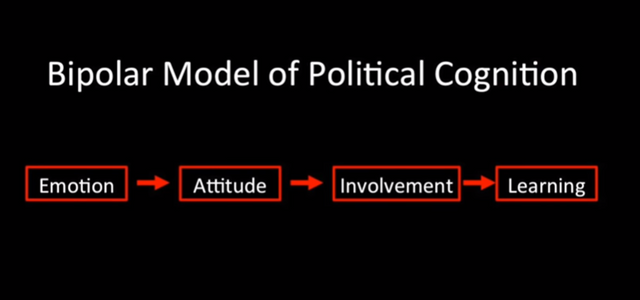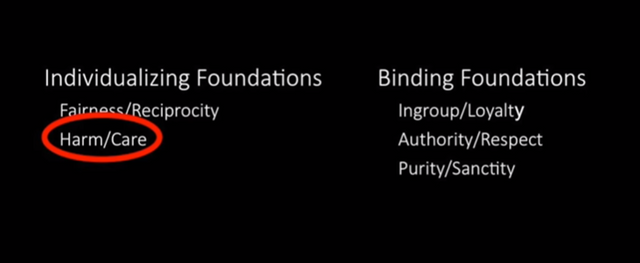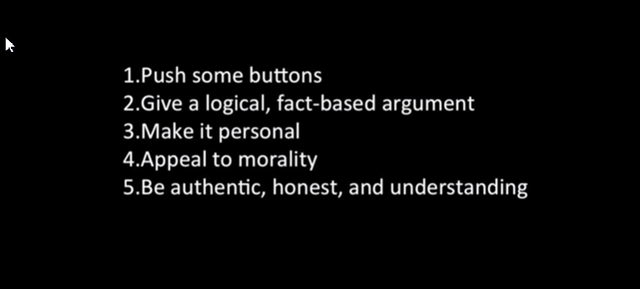How To Debate Psychologically, Not Ideologically
I really think it's a travesty that politics has become such a taboo subject to talk about. We don't want to talk about it at family gatherings and we don't want to talk about it at bars when enjoying a drink. It's something we just seem to steer away from and that's kind of sad. It's something we should engage in. We need to talk about and we shouldn't be afraid to talk about politics.

One thing that's lost in our politics is civility. We seem to come from a place of ideology and when we come from this place of ideology what gets lost in the debate is facts. Listening to the news in current affairs on to debates on college campuses it's clear that the debates people are discussing are getting lost in ideological translations and emotional communication.
It's important to remember that facts do matter. When we're talking about politics it's important to know the facts. But what I'm going to propose to you is that there's something a little more important then just the facts and that's psychology.
Psychology Matters
We can use principles of psychology to come up with a new approach of discussing politics that kind of takes ideology out of the debate and makes us focus on one another and listen to what those you are debating with are saying.
One of the major problems within politics is that too much focus is placed on how to win a debate on a political topic. That's a problem because we seem to view politics as a sum game. It's a game of wins and losses.
The focus seems to be;
How can we on- up one another? How can we fight it out to the death? It's almost like a game of Mortal Kombat where two people enter a debate and one leaves still alive. That's really kind of nuts. So, how do we change that?
How To Debate In 5 Easy Steps
This can help you in just about any debate and will also help you see how others who are debating a topic use these tactics to debate as well.
Step 1 - Push Some Buttons
I know that sounds kind of counter-intuitive, but hear me out. Cognitive psychology tells us that we tend to remember things more when they have an emotional context. If we're in a state of arousal we're going to pay attention to what's going on around us whether we realize it or not.
You don't need to be rude or disrespectful to push someone's buttons. Just make a statement that challenges their premise or belief in some way as long as you can back up your statements with actual facts. This will arouse the listener.
Arousal leads to focus which will get their attention which leads me not to step 2 but to the **Bipolar Model Of Political Cognition. In the context of political learning, we have this model, the Bipolar Model Of Political Cognition.
When people see bipolar most of the time they think of mental health and the condition of bipolar disorder, but in this context, it means, bipolar, as a continuum, having or relating to two poles or one side or another. We're talking about emotion and taking sides on an issue.
And by political cognition, that's just the way that we learn about political issues; how we process them, code them, and how it goes into our memory. And then we can recall it.
What the bipolar model says is that you take an emotion on that continuum, from either negative to positive, and that emotion that you have is then going to lead to an attitude, either negative or positive. Bu then that attitude is going to lead to your level of involvement.
So you've got your emotion, your attitude is formed, and that's going to lead to your level of involvement or how much you're going to react or care about what is being said or debated about a particular political issue, and that is going to lead to what you learn.

Overall what this model says if you take an emotion, you give it an emotional context, that's going to affect your attitude, which is then going to affect how much attention you're willing to pay, which is then going to affect learning.
With me so far? Great. Now, this actually leads me to step 2.
Step 2 - Give A Logical, Fact-Based Argument
After you got your audience a little wound up emotionally enough to get their attention, again being respectful, you then give them your argument. You give them a well-formed, logical, fact-based argument.
You can see this principle in marketing all the time. Imagine you're sitting there watching television and a commercial comes on. You hear music in the background, you see an attractive couple running on the beach who are usually heterosexual, but that's a topic for another day, and then you see them dancing in a club or drinking cocktails. The ad had gotten you aroused through this imagery and then they hit with the logic and facts the ad is about. They draw you in with the emotional components of the ad and them give you their argument.
Step 3 - Make It Personal
Give them something that they can cling to, something they can relate to. This kind of speaks to something called the Franklin effect.
The Ben Franklin effect is a proposed psychological phenomenon: a person who has already performed a favor for another is more likely to do another favor for the other than if they had received a favor from that person. An explanation for this is cognitive dissonance. People reason that they help others because they like them, even if they do not because their minds struggle to maintain logical consistency between their actions and perceptions. source
When you give a persuasive argument that someone can reach out to and connect with, that they can feel, that's going to affect attitude, that's going to change your attitude a little bit.
Step 4 - Appeal To Morality
Appeal to a person's sense of morality. When you hear the word morality, often we think about specific moral behaviors or think of it in the context of religion or spirituality, the there' really so much more to the idea of morality.
Moral foundations theory takes into account, motivation, it draws from cultural anthropology, sociology, biology, psychology; it pulls in a lot of things. What moral foundations theory tells us is that while there are five different dimensions of morality there are basically two main foundations.
The Individualizing Foundations really deal more with social justice, equality, how we treat one another, and how we avoid doing harm to other people.
While the Binding Foundations deals more with adherence to traditional values, submission to authority, and how we should behave according to group norms.
These foundations are drawn from a number of different disciplines and brought together under one core idea.
The interesting thing about these two foundations in reference to politics is that liberals tend to be more in line with individualizing foundations while conservatives tend to be more in line with the binding foundations. You can see this played out in politics today and the whole rhetoric we've got going on in our political campaigns right now.
But there is one little discrepancy in this. And that is harm and care.

Although liberals do score significantly higher in harm and care than conservatives, conservatives score well above the average. People who consider themselves moderates score about the same across all foundations.
But it's the harm and care that everyone seems to score about the same on. Most people care and don't want to harm others even when they disagree with them. So, if you can appeal to a persons sense harm and care, then you can kind of sway their motives which is going to sway their attitudes.
Can we frame political arguments and shift moral arguments?
One technique used in sales that is very effective is using third-party stories. When a prospect’s objection sounds like a past client’s situation, simply use that past client’s story. Whenever you tie your customer’s concern with an actual true story (a story with a happy ending!), you create instant credibility.
Used in conjunction with the Feel, Felt, Found technique this works to change people's attitudes about something they are resistant to.
Create empathy with your client by telling them you understand how they “feel”. It tells them that you’re listening and it creates rapport. Moving on to “felt” tells them they’re not alone. You’ve worked with people who have felt the same way. It moves their focus off the objection and moves them to a place of trust. Finally, the “found” is a way to come to a resolution and show them that there is still a way to work it out.
- FEEL: “I understand how you feel.”
- FELT: “In fact, that’s not the first time I heard that – others have felt that way, too.”
- FOUND: “And what they found was… (explain to them how you resolved the concern).”
Step 5 - Be Authentic, Honest, And Open-Minded
The final step is to be authentic, honest, and open-minded. We really need to recognize, in the political context, that there are different views and that those different views don't necessarily make us opponents. When you just yell at each other and bring ideologies into it, the debate gets lost. We stop hearing each other or communicating.
Your political views may be different from mine, but, to you, your views are no less valid than my views are valid to me and we need to understand that about people, so, be open-minded when you're talking about these things.

Using these techniques you may not convince everyone or change people's attitudes completely about a political debate, but you can at least discuss different sides of a debate with some measure of civility and open someone's mind to different views on a subject giving them something to think about rather than digging in deeper to their ideology.
What I want to leave you with here today is don't be afraid to talk about politics, get out there and engage. That's the only way things are going to change is if we openly discuss it. Just take a different approach to it. Think about psychology and think about how that person that you're talking with thinks, how they actually tick. Don't bring in ideological talking points which most of the time will not be effective. Really try to hear people, engage, and discuss these things.
Luzcypher's Announcement For Steem Witness



